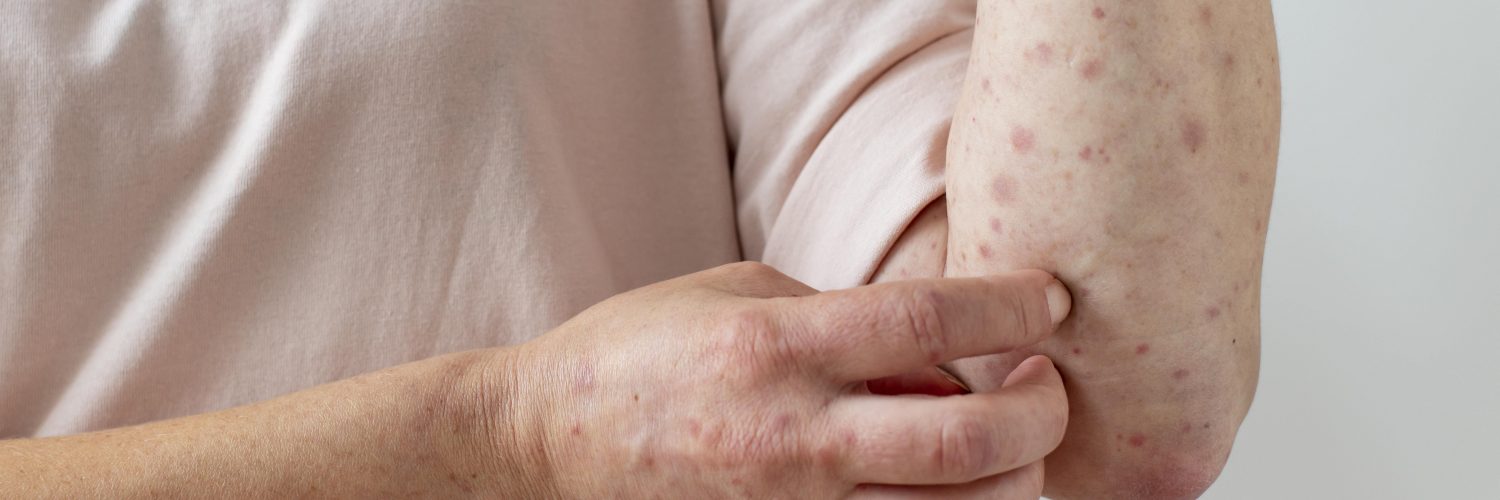Parshios Tazria and Metzora detail the laws of the Metzora. There are multiple types of Tzara’as and many Mitzvos relating to the identification of Tzara’as, the laws of impurity, and the procedures for purification.
Tzara’as is essentially a skin disease, and the identification of specific skin diseases as Tzara’as is unclearand based mainly on educated guesses. Despite this, it is possible to identify Halachic Tzara’as according to the descriptions given in the Torah, as interpreted by Chaza”l, and as codified by the Rambam (Hilchos Tumas Tzara’as).
In recent years, discussion has arisen among the Poskim as to the practicability of the laws of Tzara’as nowadays, especially following the publication of an essay of haGaon Rav Asher Weiss Shlit”a in Minchas Asher, Parshas Tazria (Siman 27[1]). In a subsequent article in Assia[2], R’ Dr. Sodi Namir also addressed this question, quoting several sources and referring to the Minchas Asher. In the last part of his article, he presents a wide variety of contemporary skin diseases that can be associated with the various forms of Tzara’as in the Torah.
The subject is broad; we will not be able to review it exhaustively. We will briefly consider some key sources and discuss a question of practical relevance relating to the use of various products for the treatment of hair loss.
The Sifra (Metzora 1:1) clearly states that the Mitzva of Metzora is practiced b’Zman haZeh. It also relates (ibid. 3) that R’ Yehuda said that R’ Tarfon (who was a Kohen) told him that he purified three Metzora’im, even though he lived after the destruction of the BeisHamikdash. The Kesef Mishna (Hilchos Tumas Tzara’as 11:6) writes that the Rambam derived from the Sifra that the laws of Tzara’as apply even after the destruction of the BeisHaMikdash.
On the other hand, the Midrash Lekach Tov (Pesikta Zutrasa, Shemos 4:6) cites Rabbi Yochanan who said explicitly: “There is no impurity of the Metzora following the destruction of the Beis Hamikdash”.
In the Sifrei haPoskim, we find almost no reference to the laws of Tzara’as nowadays. They are also omitted by the Tur and the Shulchan Aruch[3] and there is almost no reference to them in the halachic responsa throughout the generations.
At the end of his introduction to Maseches Negaim – “Marei Kohen” (39), the Tiferes Yisroel states:
I have always wondered why they don’t practice this today. I recalled that in my childhood I posed this question to the great Gaon, R’ Akiva Eiger zt”l and he responded that he was also puzzled by this and that he had no plausible answer.
The most common approach to this question assumes that we do not practice these Halachos today because our knowledge of Negaim is deficient. This approach is proposed by haGaon Rav Asher Weiss Shlit”a in Minchas Asher (ibid.) based on an inference from the Sefer haChinuch (Mitzva 170, 171 and 173). The Sefer haChinuch usually states, at the end of each Mitzva whether it is practiced in our time and who is obligated to do so. Regarding the Mitzva of Tzara’as, he emphasizes that these Mitzvos are only practiced when there is a Kohenwho is an expert in Negaim. For example, in Mitzva 170 he states: “It applies to males and females, wherever and whenever there is a learned Kohen to see the Negaim“.[4]
This implies that although, in principle, the Mitzva applies even after the Beis haMikdash was destroyed, it is not practiced because there is no one who can deal with the laws of Negaim due to a lack of expertise.
Rav Asher notes that it is astounding to say that there is a Mitzva that applies nowadays but rabbis over the generations did not bother to teach their students, children, and grandchildren its details and specifics as they did for all the other Mitzvos.
At any rate, the Sefer haChinuch’s statement clarifies why the Poskim did not deal with these Halachos: they were not sufficiently known and people were not knowledgeable about them. Anyone who is not familiar with the appearance of the Negaim is not allowed to rule upon them (Rambam, Hilchos Tumas Tzara’as 9:2). The Ra’avya states (840):
I was not required to explain the laws of Tzara’as, because the Kohen did not see it (the Kohen did not see the Nega) nor are we [sufficiently] familiar [with the Halachos] to examine [the Nega], and all the Halachos of Metzora are not practiced today. However, we distance ourselves from them because of the danger (since there is no benefit in the Kohen seeing the Nega, one must stay away from Metzora’im for fear of danger, since Tzara’as is a contagious disease).
The Radvaz writes similarly in Metzudas Dovid. He explains that after the Talmud was sealed (I.e., in the post-Talmudic era), they were not knowledgeable about Negaim. This is also stated by the Maharam Chagiz in his sefer Eileh haMitzvos: “Now we do not have a knowledgeable person who knows about the appearances of Negaim”.
The Aruch haShulchan he’Asid summarizes (Taharos 97:12):
It is astounding that the purification of the Metzora is not practiced today. If [you argue] that it is because of priestly lineage, on the contrary, all Kohanim today have the assumed status of Kehuna, as none of them have a document [proving their] Yichus, and the [fact that they still perform the] Pidyon haBen proves it. Even at the time of the Gemara, we do not find that they practiced the purification of Metzora’im. It seems to me that we are not familiar with the appearance of Negaim for we are not even expert in the shades of red of Dam Nida, nor were the Amora’im aware of them as stated at the end of Perek 2 of Maseches Niddah (19b).
The Acharonim present several approaches to this subject:
1) The Tiferes Yisrael writes that it is impossible to purify a Metzora without shaving his entire head with a razor which is an Issur d’Oraisa but set aside by the Mitzva of shaving. Today it cannot be set aside since the Kohanim are not certain of their lineage.
Rav Asher rejects this assumption, pointing out that it does not clarify why at least the Mitzva of Tumas Metzora should not be practiced, given that it should not depend on whether it is possible to observe the Mitzva of Taharas Metzora.
2) The sefer Toldos Adam (1:6) cites Rav Zalman of Volozhin (the brother of Rav Chaim Volozhin), who explains that rendering Negaim Tamei or Tahor requires a Kohen Meyuchas, which does not exist nowadays (unlike the view of the Ya’avetz who writes in his sefer Birchas Shamayim that the Halachos of Negaim do apply today). Rav Asher adduces support for this approach from the Rambam’s ruling in (Hilchos Terumos 7:9): “A Metzora is like one whose impurity comes out from his body, and a Kohen Meyuchas will render him Tamei, but before the Kohen renders him Tamei he is pure.”
In fact, the Radvaz (ibid.) explains that this is why Tumas Negaim is not practiced nowadays: “For the purification of the Metzora applies in Eretz Yisrael and in Chutz laAretz, both before and after the Beis Hamikdash. Certainly, the reason we do not practice it is because a Kohen is not among us now.”
(Rav Asher explains that the Ya’avetz’ opinion is consistent with his comments in Sheilas Ya’avetz (1:138) where he opines that declaring Negaim Tamei does not always depend on a Kohen; when there is no doubt that a Nega is Tamei no Kohen is required at all.)
Based on the above, Rav Asher clarifies the puzzling Machlokes between R’Tarfon who dealt with matters of Negaim and R’ Yochanan who ruled that they are no longer practiced. R’ Tarfon, who lived soon after the Churban, had certain priestly lineage and thus could render judgment on Negaim. However, as years passed and the number of certain Kohanim dwindled, R’ Yochanan ordered that these laws were not to be observed anymore.
3) The Or Same’ach (Hilchos Tumas Tzara’as 11:6) cites the Rambam in Peirush haMishnayos (Negaim, end of 14[5]) who discusses whether it is permissible for a Metzora to be shaved – which, as stated above, is prohibited by the Torah but set aside by the Mitzvah of Giluach – at a time when there is no Beis haMikdash and it is not possible to offer the Korbanos of the Metzora and complete his purification.
4) He also states: “The color of Tola’as Shoni (scarlet wool) may have been forgotten just as the Techeles and Chilazon have been forgotten… thus it is not possible to purify a Metzora and houses [stricken by Tzara’as].”
5) Sheilas Ya’avetz (ibid. 136) discusses the Rambam‘s statement that this Mitzva is even practiced today. He contends that “this was only said when there was Mei Chatas in Eretz Yisroel as it was still in the days of the sages of the Talmud.” (He means to say that the Metzora‘s purification without Mei Chatas water is impossible.)
However, this is far from clear, as Rav Asher pointed out. Mei Chatas water is nothing more than “Mayim Chayim” (spring water), which is easily found today and whose laws are clear. (The source of the Ya’avetz’ contention that Mei Chatas was available in the times of the Gemara is Nida 6b. The Rishonim note that the Gemara implies that the ashes of the Parah Adumah were available in those times, though they do not make this same observation regarding Mei Chatas. See the Mishneh laMelech, Hilchos Avel 3.)
We must note that the foregoing approaches only explain why we no longer purify a Metzora, not why the laws of Tumas Metzora should not be practiced.
Therefore, Rav Asher offered another approach. He suggested that there is no Mitzva to pronounce a Metzora Tamei if cannot be purified. This is akin to Chazal’s Drasha from the Pasuk of “l’Taharo Oh l’Tam’o” (Vayikra 13:59) that teaches us that the same Kohen who pronounces the Metzora Tamei should be the one to attend to his purification process. By the same token, we only practice impurity for someone whom it is possible to purify.
Rav Asher added that according to the opinion of R’ Yehuda (Moed Katan 7a, whose opinion is accepted l’Halacha – see Rambam, Hilchos Tumas Tzara’as 9:8), there is another reason for not practicing Hilchos Tzara’as today. According to R’ Yehuda, a Chasan does not come before the Kohen to find out whether he is impure with Tzara’as to enable him to fulfill his Mitzva of marriage. The same is true of somebody who potentially has Tzara’as on Yom Tov.
The same could apply nowadays. Since, for reasons delineated above, we cannot purify a Metzora, a person who suspects he has Tzara’as should not come before the Kohen who would pronounce him Tamei for that would prevent him from fulfilling many Mitzvos for the rest of his life.
Rav Asher also offers another approach. A person does not have to spend a lot of money, make himself sick, or endure pain to fulfill a Mitzva. The same argument may be extended to observing the Halachos of Tzara’as. A Metzora who can only become impure and can never be purified is not obligated to come to a Kohen who may pronounce him Tamei, for this will cause him a great deal of difficulty: he must remain outside of the camp all of his days, is forbidden from marital relations, and must observe other restrictions.
A related, practical question has arisen in recent years following the development of several treatments for hair regrowth. The discussion centers on the comments of the Ramban on the Pasuk, “And the Nesek shall not be shaved” (Vayikra 13:30) in which he states that the Pasuk intends to warn against passing a razor over a Nesek even though there is no hair on it because when the skin is scratched it stimulates the growth of hair which would purify the Nesek. (The Ramban notes that bald people attempt to regrow their hair in this manner.)The Torah forbids any attempt to purify the Nesek in this way.
In fact, some say that all baldness qualifies as a “Nesek”, even when there is no change in the appearance of the skin (see the Ra’avad, Hilchos Tumas Tzara’as 8:1 and the Kesef Mishna and Mishneh laMelech ibid.). Thus, according to the Ramban, they say it is prohibited to attempt hair regrowth. Specifically, they note that according to the Rambam, Hilchos Tumas Tzara’as 10:1, the removal of signs of Tzara’as is forbidden even before a Kohen pronounces the Nega impure. If so, we can have no recourse to the aforementioned words of the Poskim that we do not practice the laws of Tzara’as because we do not have Kohanim with certain lineage.
Rav Asher, however, gave four reasons to permit it:
1) It is far from clear that all baldness should be considered a Nesek. The Chazon Ish (Negaim 3:4) states that a Nesek is a “sudden thing”, unlike regular baldness which develops gradually.
2) It is likely that scratching the Nesek (which the Ramban prohibited) is considered a direct stimulation of hair growth, while the various treatments of baldness are nothing more than a Grama. After all, we do not find that it is forbidden to use medicines to treat Tzara’as.
3) The other Rishonim do not interpret the Pasuk like the Ramban.
4) Even the Ramban offered this only as the simple interpretation of the text, not as a Halachic ruling.
[1] Siman 23 in the first printing.
[2] “Tzara’as b’Zman Hazeh – Basis Hilchati”, Assia 101-102, pp. 19-28, 2016. https://www.medethics.org.il/article/צרעת-בזמן-הזה-בסיס-הלכתי
[3] The Shulchan Aruch does refer to the laws of the Metzora in several places. For example, in Orach Chaim 38:13, herules that a Menuda (a person in Cherem) and a Metzora are prohibited from putting on Tefillin. A more detailed Halacha referring to a Metzora (though tangential to Hilchos Mila in which it appears) is found in Yoreh Deah (266:1): “Circumcision, whether before or after its time, sets aside Tzara’as. If there is a Baheres on the foreskin, one may cut it off with the foreskin even though cutting off the Baheres violates a Lav. However, if, after he was circumcised, the flesh has grown to the point that it does not appear to be circumcised and needs to be cut [again], if there is Tzara’as [there] it is forbidden to cut it since it is only necessary to cut it [again]mid’Rabbanan.” This indicates that the Issur to cut off a Baheres applies even today. Nevertheless, the Shulchan Aruch does not discuss the Halachos of Tzara’as in a detailed and ordered way
[4] See also Mitzvos 171 and 173.
[5] The reference in the Or Sameach is mistaken.















Add comment